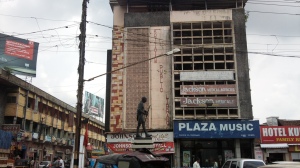11 (2) (a) A landlord who seeks to evict his tenant shall apply to the Rent Control Court for a direction in that behalf.
(b) If the Rent Control Court, after giving the tenant a reasonable opportunity of showing cause against the application, is satisfied that the tenant has not paid or tendered the rent due by him in respect of the building within fifteen days after the expiry of the time fixed in the agreement of tenancy with his landlord or in the absence of any such agreement by the last day of the month next following that for which the rent is payable, it shall make an order directing the tenant to put the landlord in possession of the building, and if it is not satisfied it shall make an order rejecting the application thereof by him:
Provided that an application under this subsection shall be made only if the landlord has sent a registered notice to the tenant intimating the default and the tenant has failed to pay or tender the rent together with interest at six percent per anum and postal charges incurred in sending the notice within fifteen days of the receipt of the notice or of the refusal thereof.
(c) The order of the Rent Control Court directing the tenant to put the landlord in possession of the building shall not be executed before the expiry of one month from the date of such order or such further period as the Rent Control Court may in its discretion allow; and if the tenant deposits the arrears of rent with interest and cost of proceedings, within the said period of month or such further period, as the case may be, it shall vacate that order.
1. Object
A tenant is under an obligation to pay or tender the rent in respect of the building under his occupation within 15 days after the expiry of time fixed in the agreement of tenancy or in the absence of such agreement by the last day of next month falling for which the rent is payable. Nonpayment of rent, as per contract and statutory provisions, entitles the landlord to seek possession after sending a registered notice to the tenants intimating the default. If after the receipt of such a notice a genuine tenant pays or tenders the rent together with interest at 6% per annum and postal charges, the right accrued to the landlord to get possession on this ground can defeated. Even after passing of the eviction order, a further right is conferred upon tenant to deposit the rent in arrears under clause (c) of sub-section (2) of section 11. The law requires the tenant to be dispossessed if he fails to pay the arrears even after 30 days of passing the final order, and any extension of time thereof. The tenants who have failed to pay the arrears of rent at all the three relevant times were not entitled to any discretionary relief under Article 227 of the Constitution of India.
2. Scope
Nonpayment of rent as a ground of eviction is a very weak ground as the statute provides payment of arrears at various stages to avoid any order of eviction being executed. The petition for eviction filed under this provision gets an order for the arrears mentioned in the notice only. The arrears accrued during the process of litigation is not taken care of in the section. For such arrears either the landlord has to file another petition or resort to section 12 of the Act. Although the rent is the consideration for the contract of lease, the legislature provides very little remedy against the defaulting tenant.
The Act does not provide a provision for allowing the landlord to realize the rent arrears. But the Rent Control Court can order to pay costs up to the amount due as rent arrears. There is no scope for passing money decree for recovery of arrears of rent. The execution petition seeking recovery of arrears of rent per se will not be maintainable.
3. Conditional Order
Order of eviction under section 11 (2)b is a tentative order liable to be vacated under section 11 (2) c. Even a formal application is not necessary under section 11 (2) c, just a memo or statement would suffice to vacate the order.
Eviction on the ground of arrears of rent is not absolute orders, they are conditional orders. It can be vacated by an application under S.11(2)(c) by the tenant.
Eviction order passed under S.11(2)(b) of the Act not to be executed before expiry of the period limited and the same to be vacated on deposit of arrears within that period.
Part payment of rent makes the tenant a defaulter, for he has to make full payment. Sum deposited by tenant falling short of rent due towards first default. The deposited sum cannot be adjusted against the second and third defaults as has been done by the Courts below. The tenant is not entitled to protection.
4. Rent
The court cannot take upon the duty of deciding “reasonable rate of rent payable in respect of the premises” and substitute the same for the rent due by the tenant as mentioned in Section 11(2) b.
A person who got assignment of the building has no right to claim eviction on the ground of arrears of rent which fall due before his assignment unless the right to collect arrears of rent has also been assigned to him by the same document.
Rent is the consideration in lieu of enjoyment of property payable upon accrual of periodical liability.
Landlord was a partner, and on dissolution of the firm the landlords claim of arrears up to the date of dissolution was considered as debt as per the partition deed. There after the landlord cannot claim the arrears under section 11 (2) b. It is only a debt.
When the landlord and tenant agree that the latter is liable to pay rent as well as the municipal tax for the building it is not possible to hold that the stipulation for the payment of municipal tax contravenes is aginst the Rent Control Act.
5. Period of arrears
The Rent Control Court is entitled and has got jurisdiction to pass an order on the basis of rate of rent or period of the arrears as stated by the tenant if the landlord failed to prove his case reagarding these two factors.
Landlord was a partner on dissolution of partnership settlement was executed by the partners on 16/10/1999 and shop rooms have been partitioned among partners. Landlord’s right to claim arrears of rent is controlled by terms of settlement. Arrears prior to 16/10/1999 can be considered as debt for which landlord is not entitled to seek eviction under S.11(2)(b).
The rent is merely a debt. Therefore, whatever might have been due prior to deed of lease could not constitute arrears of rent. It was mere actionable claim.
6. Error in Notice
Error on the quantum of rent is of little consequence while quantifying arrears for the purpose of passing orders. The intimation to the tenant that there is default in payment of rent only is relevant.
7. Civil Suit
Civil Courts jurisdiction to decide question of arrears of rent is not ousted by virtue of Section 11 (2) of the Act. A tenant can be evicted for arrears of rent only under 11 (2) of the Act but the Civil Courts jurisdiction to decide question of arrears of rent is not ousted by the said provision.
The rent arrears is an actionable claim which can be transferred by the landlord.
Section 3 of the T.P. Act defines actionable claim:
8. Rate of interest in civil suit
Section 11 (2) b specifies for 6% interest for arrears. But in a suit for realization of rent, the plaintiff can claim for interest at reasonable rates according to the respective nature of use of the building as commercial or residential. With regard to the rate of interest on the claim for money due as rent arrears in civil suits Section 34 of the CPC has to be prevailed. A tenant is bound by the statute to pay interest at the rate of 6% p.a. over the defaulted amount of rent. Any contra stipulation in the rent deed has no bearing over the provision. Nevertheless in civil suits the landlord is entitled to recover interest on the arrears of rent on the basis of rent deed.
9. Condition for eviction
Arrears of rent is a ground adopted from Transfer of Property Act Section 108(L) and incorporated in Kerala Buildings (Lease and Rent Control) Act to evict a tenant. To constitute that ground for eviction the landlord has to send a registered notice to the tenant intimating the default and the tenant has failed to pay or tender, the rent due together with six percent interest and postal charges incurred in sending the notice within fifteen days of the receipt of notice.
The cause of action arises when landlord sends the above-mentioned notice and 15 days have to be elapsed without payment or tendering the amount due by the tenant.
Rent Control Court has got jurisdiction under S.11(2)b to adjudicate rate of rent, period of arrears etc as stated by the tenant, if the court finds that landlord failed to prove his case on this issue.
10. Defenses
For a petition for eviction on the ground of Arrears of rent under section 11 (2),
(i) Deny the rate of rent and period of arrears so that landlord has to prove both these aspects.
(ii) Deny the service of notice, because the service of notice is a mandatory condition.
(iii) The tenant can take the defense that the building does not belong to the petitioner and thus deny the title of the landlord. Though the landlord cannot evade the Rent Control Act the tenant can evade the summary procedure prescribed in the Rent Control Act by just denying the title of the landlord. The landlord has to go to the Civil Court and there too the tenant gets all the protection of the Rent Control Act. The landlord has to prove the ground under the Rent Control Act in the civil court also, after proving his title, the tenant is not deprived any of his right by denying the title of the landlord.
(iv) Apply for extension of time for payment of arrears, this extension of time can be given according to the discretion of the court and there is no limit.
(v) After all the procedure, i.e. Appeal and revision, deposit the arrears within 30 days of last order. This deposit need only for the original arrears as per the petition, the arrears accrued during the petition need not be deposited, in order to avoid eviction.
The conduct of tenant in the proceedings cannot be taken against him when deciding the case on merit. Any of the ground under this Act is to be proved to evict the tenant. Order must be in terms of the provisions of the Act.
Payment of substantial amount by tenant towards construction cost of building and expenditure for improving the building for the purpose of business is a valid defense for ground of eviction under S.11(2)(b.
11. Service of Notice
Fifteen days after the receipt or refusal of the notice by the tenant, the landlord can make an application to the Rent Control Court to evict the tenant. If the Rent Control Court is satisfied that the tenant has not paid the rent due by him within 15 days after the expiry of the period fixed in the agreement of tenancy and in the absence of any such agreement, by the last day of the month next following that, for which the rent is payable (e.g. Rent for the month of February is in arrears on 31st day of March) the court shall make an eviction order. This eviction order is a conditional order and will be kept in abeyance for one month or such further period as the Rent Control Court may in its discretion allow and if the tenant deposits the arrears of rent with interest and cost of proceedings within the said period the court shall vacate the order. The Rent Control Court can extend the period at its discretion for such other period.
Heirs are joint tenants. Notice to one of the joint tenant is sufficient and the petition maintainable. Notice issued in earlier petition is not sufficient for institution of subsequent proceeding for eviction on arrears of rent.
The legal heirs of the original tenant are joint tenants and not co-tenants. The lawyers notice issued to the original tenant satisfies the requirement under the Proviso to section 11(2)b.
On admission by tenant, Rent Control Court passed an order of eviction on the ground of arrears of rent and granted the tenant a month’s time to deposit the arrears. Tenant failed to deposit the arrears. An appeal filed by the tenant against the order is not maintainable. Tenant cannot be said to be aggrieved, within the meaning of section 18, by an order based on consent.
The amount which the tenant is liable to deposit for the purpose of S. 11(2) is only the rent due at the time of notice and that the Landlords remedy for rent subsequently falls due will be to invoke S. 12 of the Act.
Every tenant is obliged to pay or tender rent to the landlord within 15 days of the month to which the rent relates. The purpose of advance rent is to protect the landlord from the unscrupulous tenant who may run into arrears and vacate the premises and comfortably walk away with arrears The advance rent is available for adjustment or is liable to be refunded at the time of vacating of the premises except where the law or the contract between the parties provides to the contrary.
Landlord borrowed an amount from tenant for construction of tenanted premises. The terms of the agreement definitely casts an obligation on the tenant to pay rent in respect of the premises occupied by him. Rent Control Petition for eviction is maintainable as a landlord – tenant relationship exists between them. Consequently, the provisions of the Rent Control Act are applicable.
Act II of 1965 does not take the civil court’s jurisdiction for recovery of arrears of rent away. The decision in the suit and appeal will be binding on the petitioner.
The Act does not provide a provision for allowing the landlord to realize the rent arrears. But the Rent Control Court can order to pay costs up to the amount due as rent arrears.
12. Rent advance
Where the arrears of rent is smaller than advance amount held by the landlord on account of the tenant, there is no default of rent. Hence if the tenant has evidence of deposit or advance he need pay rent after the deposit is exhausted.
The landlord can get advance from the tenant as security to be returned to the tenant on vacation of the premises. The landlord on his own volition may adjust the advance amount towards arrears of rent but the tenant cannot insist that the landlord should adjust the advance towards rent arrears. The tenant cannot adjust the advance rent towards arrears of rent on his own volition.
13. Value of improvements
Value of improvements made by the tenant on the building cannot be considered by Rent Control Court. Value of improvements made by the tenant cannot be raised in a rent control proceeding even if done with the knowledge and consent of the landlord.
Tenant invested substantial amounts towards improving the building with the consent of the landlord. Unless and until the amount expended towards improving the building is paid back, the landlord is not entitled to seek eviction.
14. Rent Arrears and Limitation Act
The court’s order to vacate will come into effect or crystallize as resjudicata depending upon the action of the tenant. If the tenant deposits the arrears after the judgment is pronounced within the time stipulated the order of the court becomes inoperative. If he fails to deposit or tender the arrears then the order can be executed by evicting the tenant. The reason behind the section is not to secure the benefits of rent to the landlord if the tenant occupies the building, but to protect the tenant from eviction even if he is a defaulting tenant. The primary right of the landlord to get the quid pro quo is uncared for by the Act.
Under S.11 (2) (b), order of eviction can be passed only on satisfaction that the tenant has not paid or tendered the rent due. But the arrears contemplated in S.11 (2) (c) for vacating the order include not only the arrears recoverable through a court of law, but also time barred arrears.
Limitation Act is applicable to the amount due as arrears of rent, but if the tenant wants to continue in the building as a tenant, he has to pay all arrears of rent irrespective of limitation period. But if the tenant vacates the building the landlord can recover the arrears of rent that is within the limitation period by way of a civil suit.
15. Maximum time for disposal Rule 7 (5)
Rule 7 (5) of The Kerala Buildings (Lease and Rent Control) Rules, 1979
Rule 7 (5) Every application for eviction under clause (a) of sub-section (2) of section 11 of the Act, shall as far as possible, be disposed of within a month from the date of filling of the application and if the tenant does not hand over possession within such time as may be specified in the order, the Rent Control Court may take possession of such building by forceful eviction and handover the same to the applicant.
The principle behind the fixation of time limit is that the landlord’s important right to get the rent should be preserved. In the case of arrears of rent no separate execution petition is to be filed, the Rent Control Court itself can take possession of such building by forceful eviction and handover the same to the applicant, if the tenant is neither paying rent nor handing over the possession of the building within the time specified in the order. This rule has got little significance on the light of Section 11 (2) c. This rule is just an eye washer, to cover-up the harsh realities embedded in the Act.
The Rent Control Authorities have the power to extend the time originally granted for the deposit of arrears of rent confirmed in appeal. The Rent Control Court has got the discretion to allow time more than once to the tenant to pay arrears of rent with interest and cost of proceedings under S.11(2)(c) after the expiry of statutory period of one month.
16. Execution
Execution court does not have the right to order restitution under S. 11(2) c. When an order under section 11 (2) (b) is put in execution the execution court is not empowered to receive evidence as to whether arrears of rent, interest or cost has been paid or not.
17. Subsection (c ) and enlargement of time
Eviction on the ground of arrears of rent was allowed. Extension of time was granted once. Rent Control Court has got no power to grant further extension of time after the expiry of the time granted earlier. (Overruled by Karthyayani v. S.N.D.P. Sakha Yogam 2004 (3) KLT (FB))
The Rent Control Court can allow time more than once to the tenant to pay arrears with interest after the expiry of statutory period. Either the Act nor the courts do not recognize or respect the right of the landlord to get even the rent which is the consideration for the rental agreement.
Section 5 of the Limitation Act, 1963 is not applicable where there is a default in depositing the rent by the tenant. The provisions of Section 5 of the Limitation Act must be construed having regard to Section 3 thereof. For filing an application after the expiry of the period prescribed under the Limitation Act or any other special statute a cause of action must arise. Compliance of an order passed by a Court of Law in terms of a statutory provision does not give rise to a cause of action. Instant consequences are provided for under the statute, when there is failure to comply with an order passed by a Court of Law. The court can condone the default only when the statute confers such a power on the Court and not otherwise. In that view of the matter we have no other option but to hold that Section 5 of the Limitation Act, 1963 has no application in the instant case.
Power to enlarge time in the matter of making requisite deposit under S. 11 (2) c is discretionary, it has to be exercised judiciously on sound legal principles and judicious manner on the basis of facts and circumstances. Whenever discretionary power is exercised courts often taken into account the general equities of the given case. It can be exercised more than once.
The power of the court has also been limited to the extent that it can extend time for such deposit not exceeding three months and so far as the deposit of monthly rent is concerned, by fifteen days. The court’s power, therefore, is restricted. In case tenant deposits the provisional rent as determined by the Court within stipulated period the tenant is relieved by the eviction decree.
Special leave petition is allowed and Supreme Court modifies or reverses the decision of the lower Court. The Supreme court’s decision is operative. Tenant gets benefit of S.11 (2) (c).
Arrears of rent deposited after dismissal of Original Petition filed under Article 227 within 30 days. The tenant is entitled to benefits under section 11 (2) c. 1991 (2) KLT 316 overruled.
Sub tenants cannot resort to S.11 (2) (c) of the Act to get an order u/s 11(2) of the Act.
The order of eviction, if passed against a tenant shall attain finality after the decision of the appellate authority or at the most after the decision of the revisional authority as contemplated under section 20 of the Act. If an order of eviction has been passed under section 11 (2) of the Act, the said order and direction shall become executable after the expiry of one month from the date of the final order passed by the rent control court, the appellate court or the revisional court, as the case may be, subject, however, to the extension of time granted by the aforesaid courts and authorities in terms of clause (c) of sub-section (2) of section 11. Proceedings under Act 227, not being extension of the proceedings under the Act would not automatically authorise the Court to extend the time.
How to evict a tenant and various grounds of eviction
Rent Control Act with Rules























































You must be logged in to post a comment.